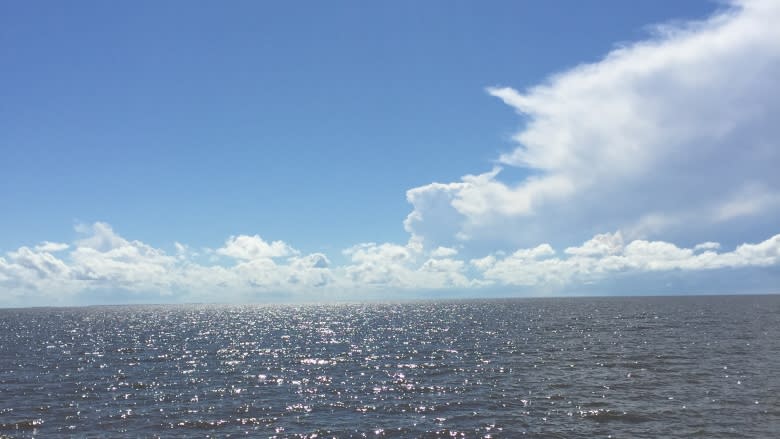That fleece you're wearing is starting to pill — and may be polluting Lake Winnipeg
In the midst of a zebra mussel invasion, algae-choked Lake Winnipeg just can't catch a break.
New research suggests the world's 11th largest freshwater basin is taking in a surprising amount of microplastic — on par with the Great Lakes — and it could be coming off the backs of nature-lovers.
Researchers found Lake Winnipeg has levels of microplastics in its waters comparable to Lake Erie, the Great Lake along Ontario's southern border that is suffering from an acute case of plastic contamination.
It was a surprising, and potentially troubling, finding for the team of scientists, who published their research in the journal Environmental Pollution in February.
"We're worried about it because of the potential effects [microplastics] can have on our ecosystems," said Mike Rennie, a senior author on the study and research fellow with the Winnipeg-based International Institute for Sustainable Development.
More surprising still was the kind of microplastics they found in Lake Winnipeg.
Polar fleece fibres
The majority of microplastics come in bead form from a range of commercial health and beauty products, as well as industrial waste. The small particles are less than five millimetres in size, Rennie says, or roughly the size of a match head.
In some cases, the plastics leach into water tables after being broken down in the washing machine and sent through sewage treatment plants.
The particles are dangerous to a range of wildlife species. Tiny zooplankton are capable of unwittingly gobbling down the plastic, as are birds and fish.
Researchers measured microplastic samples taken across Lake Winnipeg between 2014 and 2016 using the same methods as similar studies of the Laurentian Great Lakes.
But when the team got back to the lab, they noticed something markedly different from the Lake Erie samples: more than 80 per cent of microplastic from Lake Winnipeg came not from the typical beaded form, but from microfibres like those found in polar fleece clothing. No microbeads appeared in three years of sampling.
Fleece clothes can shed 'a lot' of microplastic
So in what is possibly a tragic stroke of irony, the snuggly fleece that keeps cottagers and outdoorsy folks warm might also be poisoning the ecosystem.
"Basically, if you've got an article of clothing that's got polyethylene or polypropylene … these synthetic articles will often shed fibres," Rennie said.
"Some of these clothing manufactures have been instrumental in helping fund and conduct some of the research to show just how much they can shed, and it's quite a lot."
Outdoor specialty retailer Mountain Equipment Co-Op is actively looking for solutions to the problem. It is studying microplastics in garments at its very own product testing lab in Vancouver.
While Lake Erie serves as a helpful comparison, Lake Winnipeg could have bigger issues. Lake Erie had a greater density of plastic in its waters than at least two other Great Lakes — Lake Huron and Lake Superior — but Lake Winnipeg had a greater overall volume of plastic than all three. Lake Erie's watershed is also one-tenth the size of Lake Winnipeg's, but is surrounded by a population nearly twice as big.
Not only is the population much greater in number, the people are densely crammed into a smaller space along Lake Erie's shores than in the more vast expanses around Lake Winnipeg, where communities are more spread out.
Data gap
Microplastics have been documented in marine areas around the world, but there is a data gap when it comes to freshwater ecosystems in Canada and abroad, Rennie said.
The issue requires more study before anything can be said conclusively about where all the plastic in Lake Winnipeg is coming from, but it could have something to do with the rivers that feed into the lake.
"Fewer municipalities feeding wastewater to Lake Winnipeg compared to Lake Erie suggest that (a) municipalities in the Lake Winnipeg watershed could be generating more microplastics than those around Lake Erie, and that (b) long-range transport of microplastics is facilitated on the surfaces of freshwater rivers," Rennie and the researchers state in the study.
The Saskatchewan River runs through communities in Saskatchewan and Alberta, where a total of 2.2 million people live, before it eventually spills into the northern basin of Lake Winnipeg. About a million people live along the Winnipeg and Red rivers, the authors state, which also feed into the lake.
A lot of laundry
That's a lot of potential fleece-wearers doing a lot of laundry, and a lot of soapy water travelling through sewage treatment plants and eventually back into the environment.
Previous research findings have raised concerns about what happens when microplastics inch up through the food chain into the bellies of fish.
"When these move into fish there's a concern they could be transporting contaminants, like a vector for moving contaminants from the water into fishes," Rennie said.
A Winnipeg graduate student is now studying fish in the Red River to see whether they show fleecy signs of mircoplastic contamination.



